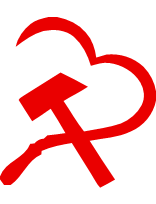I wanted to comment on this to reiterate that meditation is like exercise. Most likely you're not going to be good at at at first - you're flexing a "concentration muscle" in a way it's not used to. So at the beginning it is good to not expect it to be a walk in the park. But one should stick with it regardless. Set a realistic time for meditation, perhaps don't meditate for too long at the start. And progress may take a while. It's like starting exercising or learning an instrument.
And also, as the comment says, don't think of it as forcing your mind to be empty or forcing yourself to think of nothing. If you are trying to stop thoughts then you'll set yourself up for some disappointment at first and you will likely start forming judgement statements about yourself as being "bad" at meditating.
Instead of forcing thoughts to stop, take a brief notice of the thoughts that comes up and then let them pass without indulging in them - so don't judge them when they arise and don't follow where they want to take you - and use your breath as an anchor. And those thoughts may even be statements like "Ahhh! Why can't I focus!", if so then try to look at it like objectively like a scientist studying the mind. You can say "Ah, there's anger", and then don't follow up with it, don't indulge it, just go back to your breathing. Another thought will sure to happen, just return to the breath.
Everytime you notice that your mind has wandered go back to your breath, and that's a "rep" like CarbonConscious said. And you know what, you're gonna be doing a lot of reps! Because you're new to meditation you're mind is naturally going to wander very quickly. That's normal, don't judge yourself for it. It's a new exercise for this muscle. In fact, every time you notice you are mind wandering you are improving that muscle. So you shouldn't be upset if you mind wander. If you start judging yourself, good or bad, also just take note and don't indulge and return to the breath. Everytime you notice it and focus back on the breath you are flexing that muscle.
There was an earlier post where others give their advice on how to meditate that I'll post in case you find it interesting, meditation on the breath is very common, but there are other forms of meditation too: https://hexbear.net/post/3451587



I would love to talk about this stuff with anyone who is interested. I've learned some (linear) production theory along the lines of Sraffa, Pasinetti, Ian Wright etc - essentially representing production relations as a network. If you feel comfortable with some Linear Algebra you can start there. And I have been working on a way to model this production network, but I sometimes spin my wheels and get stuck on tangents. I am thinking of a model along the lines of what Ian Wright has worked on, and either doing a macro model (modeling the explicit emergent relations) or micro model (model the micro interactions and letting the macro structure emerge). Wright has papers for both types of models. The later would be more along the lines of complexity science. The former is closer to diff eqs, and would be easier for applying ideas of control theory to. I think.
There are a series of papers from Political Economists from the new school arguing about whether to start models from the individual interactions, vs the emergent macro conditions (which is more in line with classical political economy).
Later one could add financial networks, etc. to such a model.
But if you're familiar with linear algebra, diff eqs, and control theory, then you may find the authors above interesting. If anyone wants to brainstorm let me know. I think this stuff is interesting and would love to know more, but I also have to work to pay bills lol